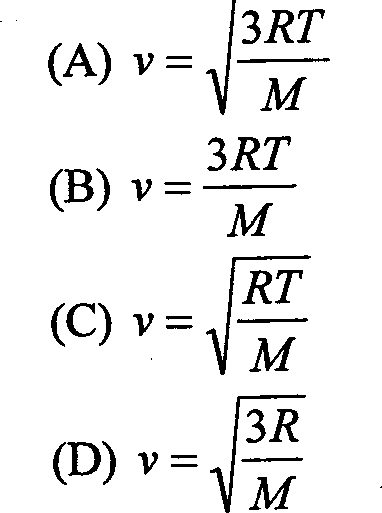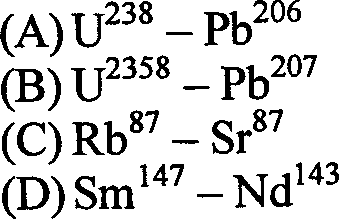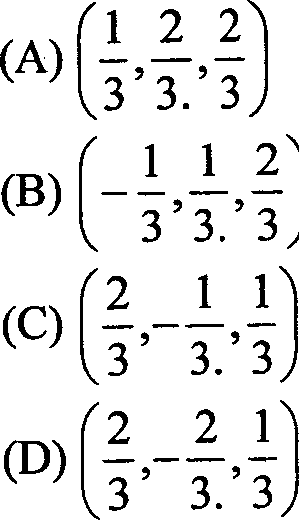University of Hyderabad (UoH) 2010 Entrance Exams Other Entrance Exams Ph.D Programme Entrance - Earth & Space Sciences - Question Paper
Ph.D Programme Entrance examination - Earth & Space Sciences
Code No: U-91
Hall Ticket No:
University of Hyderabad ENTRANCE EXAMINATION 2010-2011 Ph.D in Earth & Space Sciences
Date/Day: 03.06.2010, Thursday
Time: 2.00-4.00 P.M ___Marks: 75
Instructions to the candidates:
1. All questions carry equal marks.
2. Write your Hall Ticket Number in the OMR answer sheet given to you. Also write the Hall Ticket Number in the space provided on the question paper booklet.
3. The question paper consists of Objective Type questions of one mark each. For each question, there are four answers and the answers are to be indicated with capital letters of alphabets viz., A, B, C and D.
4. The question paper consist s of part A and part B.
5. There is negative marking. Each wrong answer carries 0.33 mark.
6. Answers are to be marked on the OMR answer sheet following the instructions provided there upon.
7. Hand over both the question paper booklet and the OMR answer sheet at the end of the examination.
8. No additional sheets will be provided. Rough work can be done in the question paper itself / space provided at the end of the booklet.
9. Non-programmable calculators are allowed.
4. Rate of diffusion of a gas is
(A) Directly proportional to its density
(B) Directly proportional to its molecular weight
(C) Directly proportional to the square root of its molecular weight
(D) Inversely proportional to the square root of its molecular weight
5. Age of the Earth (Approximately)---------
(A) 100 MY
(B) 7.5 BY
(C) 4.6 BY
(D)5.6 BY
6. Velocity of ideal gas molecule is given by the relation

7. Sandstone is a
(A) Igneous rock ,
(B) Metamorphic rock
(C) Sedimentary rock
(D)None
8. The most characteristic rocks of Island-Arc systems are
(A)Andesites
(B) Granodorites
(C) Blue Schists
(D) Basalts
9. The Triple Junction nearest to India is located in the
(A) Bay of Bengal
(B) Indian Ocean
(C) Arabian Sea
(D)Rann of Kutch

12. Most of the earthquakes of shallow focus range are caused due to
(A) Normal faulting
(B) Gravity faulting
(C) Reverse faulting
(D) Thrust faulting
13. Which of the fallowing exhibits negative gravity anomaly?
(A) Hawaiian Islands
(B) Mid-Atlantic Ridge
(C) Ryukyu & Kyushyu Arcs
(D)Marianas Trench
14. Direction cosines of the line passing through the points with position vectors i + j - 4k and 2i + 3j - 2k are

9 10 .
is
10 11
15. The trace of the matrix
(B) 20
(C) 11
16. If cot(9-30) + cot(9+30) = 0, then 0 =
(A)7t/4
(B)7t/3
(C)tc/6
17. If A is a 3x3 matrix such that detA= 6, then det(AdjA)=
(A) 6
(B) 24
(C) 36
(D)216
18. The subtropical belts of high atmospheric pressure over Oceans between the regions of the trade winds and Westerlies is called
(A) Easterlies ' (B) Doldrums
(C) Roaring forties
(D) Horse latitude
19. The line parallel to y - axis and passing through (3,-5) is
(A)y-3 = 0
(B) y+5 = 0
(C) x+5 = 0
(D)x-3 = 0
20. A jet engine works on the principle of
(A) Conservation of Energy
(B) Conservation of Mass
(C) Conservation of Linear momentum
(D) Conservation of Angular momentum
21. If the Earth were 3 times as far as from the Sun as it is now, how would the gravitational attraction compare with its present value
(A) Gravitational attraction would be 9 times its present amount
(B) Gravitational attraction would double its present amount
(C) Gravitational attraction would be 1/9 times its present amount
(D)None of the above
22. The average time interval between successive high and low tides is
(A) 24 hrs and 52 min
(B) 14 hrs and 30 min
(C) 20 hrs and 12 min
(D)6 hrs and 10 min
23. The hot and dry winds that blow in North American on eastern side of rocky mountains are called as
(A)Foehn
(B) Loo
(C) Gale
(D) Chinook
24. The experimental satellite SROSS abbreviation means
(A) Stretched Rohini Satellite Series
(B) Super Rohini Satellite Series
(C) Subsystem Rohini Satellite Series
(D) Sub contracted Rohini Satellite Series
25. A physical balance works on the
(A) Principle of moments
(B) Law of conservation of momentum
(C) Law of parallelogram of forces
(D)Law of conservation of energy
PART-B
26. A sudden fall in Barometric reading indicates
(A) Cold
(B) Snowfall
(C) Strom
(D) Heavy rain
27. Dolerite is
(A) Volcanic basic rock
(B) Plutonic basic rock
(C) Hypabyssal basic rock
(D) Plutonic acidic rock
28. A coarse-grained, rudaceous, siliceous rock is known as
(A) Conglomerate
(B) Breccia
(C) Arkose
(D)Grit
29. Confined water is found
(A) Above the water table
(B) Below the water table
(C) Between the aquiclude and aquifer
(D) Between the aquifuge and aquifer
30. The velocity of P waves in the inner core is
(A) 20.45 km/sec
(B) 18 km/sec
(C) 15.20 km/sec
(D) 11.23 km/sec
31. The flattest portion of the Earths surface is formed by
(A) Abyssal Hills
(B) Abyssal plains
(C) Oceanic rises
(D) Oceanic trenches
32. The Mid-Atlantic ridge system is an area of
(A) Shear plate boundary
(B) Consuming plate boundary
(C) Accreting plate boundary
(D) Stable plate boundary
33. The Tethys sea was located between
(A) North America and South America
(B) North America and Eurasia
(C) Eurasia and Africa
(D) Antartica and Australia
34. Which of the following has the youngest oceanic crust?
(A) Pacific Ocean
(B) Atlantic ocean
(C) Arctic ocean
(D) Indian ocean
35. The fastest spreading of the sea floor is exhibited by
(A) South Atlantic Ridge
(B) North Atlantic Ridge
(C) Central Indian Ridge
(D)East Pacific Rise
36. The water which is trapped in a sediment or bed against gravity is called
(A) Capillary water
(B) Gravitational water
(C) Hygroscopic water
(D)None of the above
37. The imaginary line on the Earths surface which closely follows the 180 meridian is
called
(A) Tropic of Cancer
(B) International Date line
(C) Equator
(D) Tropic of Capricorn
38. Rusting of iron is an example of
(A) Rapid oxidation
(B) Spontaneous oxidation
(C) Slow oxidation
(D) Reduction
39. Chemically, vitamin C is
(A) Ascorbic acid
(B) Acetic acid
(C) Tartaric acid
(D) Citric acid
40. The element essential in all organic compounds is
(A) Nitrogen
(B) Sulphur
(C) Carbon
(D) Chlorine
41. Which substance is produced by fermentation?
(A) Chlorine
(B) Carbon dioxide
(C) Nitrogen dioxide
(D) Sulphur dioxide
42. Radiocarbon dating technique is used to estimate the age of
(A) Rocks
(B) Soil
(C) Buildings
(D) Fossils
43. Spatial data can be described as
(A) Data that has a geographic element
(B) Data containing an area attribute
(C) Data concerned with measurements
(D)Data containing vector attributes
44. A solution of washing soda in water is
(A) Acidic
(B) Neutral
(C) Bleaching
(D) Alkaline
45. A solution of a pH of 11 is
(A) More alkaline than a solution of pH 8
(B) Less alkaline than a solution of pH 8
(C) More acidic than a solution of pH 8
(D) Neither acidic nor alkaline
46. Of the following, the one representing a physical change is
(A) Rusting of iron
(B) Freezing of water
(C) Burning of coal
(D) Souring of cream
47. A deuterium nucleus consists of
(A) One proton and two electrons
(B) One proton and one neutron
(C) One proton and three neutrons
(D) One neutron and two protons
48. Corundum is an ore of
(A) Aluminium
(B) Magnesium
(C) Boron
(D)Berrylium
49. Brass is an alloy of
(A) Copper and Zinc
(B) Copper and Tin
(C) Copper and Nickel
(D) Copper, Zinc and Nickel
50. Largest constituent of cement is
(A) Silica
(B) Calcium oxide
(C) Alumina
(D) Ferric oxide
51. When two mercury drops are brought into contact, they form a bigger drop because liquids have a tendency to possesses
(A) Minimum surface area
(B) Minimum volume
(C) Maximum size
(D) Maximum surface area
52. Which of the following is more viscous
(A) Alcohol
(B) Water
(C) Honey
(D) Gasoline
53. When iron rusts, its weight
(A) Decreases
(B) Increases
(C) Shows no change
(D) Decrease and then increase
54. The density of sea water decreases as
(A) Depth and salinity increases
(B) Depth increases and salinity decreases
(C) Depth and salinity decrease
(D) Depth decreases and salinity increases
55. When a ship enters a sea from a river, it
(A) Rises
(B) Remains at the sea level
(C) Sinks a little
(D) Rises or sinks depending on the material it is made of
56. The angle between geographical and magnetic meridian is called
(A) Angle of dip
(B) Latitude
(C) Angle of declination
(D) Angle of inclination
57. A square coil of 0.01m2 area is place perpendicular to the uniform magnetic field of intensity 103 w/m2. The magnetic flux linked with the coil is
(A) 10 weber
(B) 10'5 weber
(C) Zero
(D)100 weber
58. The direction of induced current is such that it opposes the very cause that has produced it. This is the law of
(A)Lenz .
(B) Faraday
(C) Kirchhoff
(D) Fleming
59. X- rays are not emitted out from H-atom because
(A) Energy levels are very close in H-atom
(B) Energy levels are farther apart in H-atom
(C) Its size is very small
(D)It contains one electron
60. The elliptical orbits of electron in the atom were proposed by
(A)J.J.Thomson
(B) Bohr
(C) Somerfield .
(D)de Broglie
61. In a given reaction z XA ->Z+1YA -Z_1KA~4 -Z_XKA~* radioactive radiations are emitted in the sequence
(A) a, p,y
(B) p, a, y
(C) y, a, P
(D)P>Y>a
62. Velocity - time curve for a body projected vertically upwards is
(A) Parabola
(B) Ellipse
(C) Hyperbola
(D) Straight line
63. The number of neutrons in a chain reaction increases in
(A) Arithmetic progression
(B) Geometric progression
(C) Harmonic progression
(D)None of the above
64. The minimum value of the quadratic expression 3x2 + 2x + 11 is
(A) 32/3
(B) 28/3
(C) -28/3
(D) -32/3
65. Isohytes are the points joining the areas of equal
(A) Pressure
(B) Temperature
(C) Rainfall
(D) Salinity
66. The equation of the normal to the curve 2x2 - xy - y2 = 0 at (1,-2) is
(A)x + 2y + 5 = 0
(B) x - 2y - 5 = 0
(C)2x + y-5 = 0
(D)2x-y + 5 = 0
67. A random variable X has mean 2 and E(X2) = 6, then the standard deviation of X is
(A)V6
(B) V2
(C) 2
(D) 4
68. The mean is a measure of the data for
(A) Variability
(B) Position
(C) Central tendency
(D) Symmetry
69. If we computes the mean for a set of % Fe grades and then subtracts this mean from each grades, the SUM of the resulting set of difference grades will equal
(A) Zero
(B) Unity
(C) n, the number of scores
(D) n times the mean
70. If A2 - A +1 = 0, then the inverse of A is
(A) A +1
(B) A
(C)A-I
(D) I - A
71. A straight line through the point A (3, 4) is such that its intercept between the axes is bisected at A. Its equation is
(A)x + y = 7
(B) 3x - 4y + 7 = 0
(C) 4x + 3y = 24
(D) 3x + 4y = 25
1 1
72. The modulus of the complex number --ry is
1-(1-/)2
(A)0
(B) 1
(C)-l
(D)2
73. What is the value of factorial Zero (0!)?
(A) 10 .
(B) 0
(C)l
(D)-l
74. In a set of 10 scores, the value 1 occurs 5 times, the value 4 occurs thrice and 6 occur twice. What is the mean of the scores?
(A) (1 + 4 + 6 )/3
(B)(l +4 + 6)/10
(C)(l*5 +4*3 + 6*2)/4
(D)(l*5+4*3+6*2)/10
75. In a data set of 100 values of Fe and Si02, it was established that there is negative linear relation ship between Fe and SiC>2. This means
(A) As Fe increases Si02 decreases
(B) As Fe increases Si02 also increases
(C) There is no change in Fe or Si02
(D) There is no change in Fe where as Si02 changes
Paper ends
|
Attachment: |
| Earning: Approval pending. |
